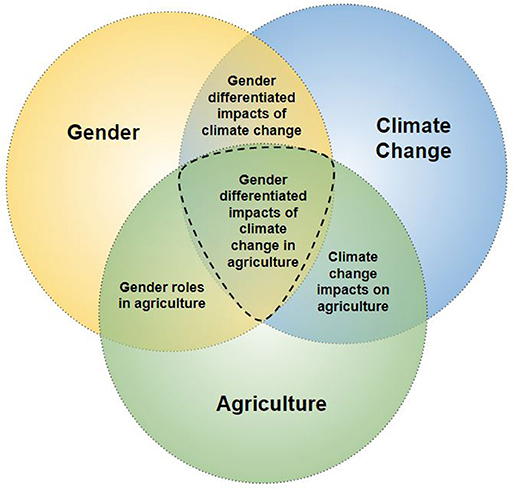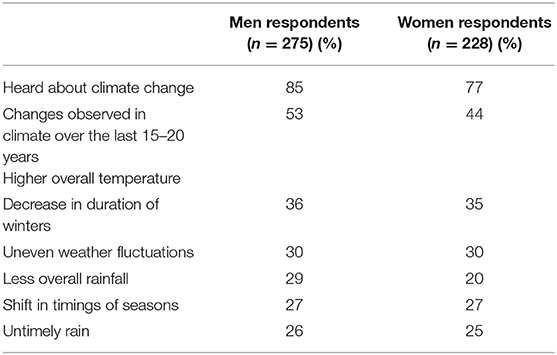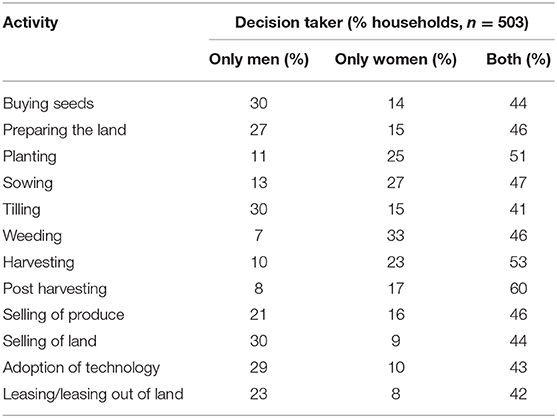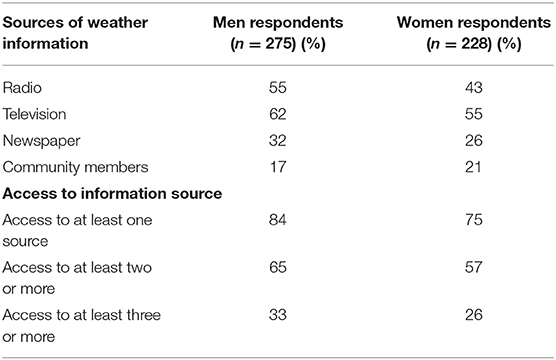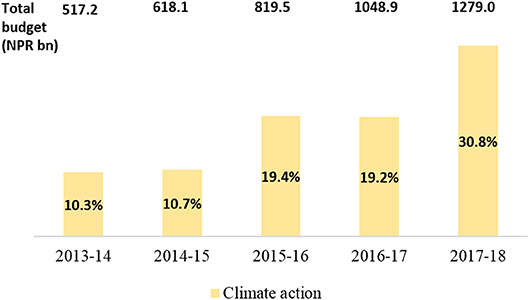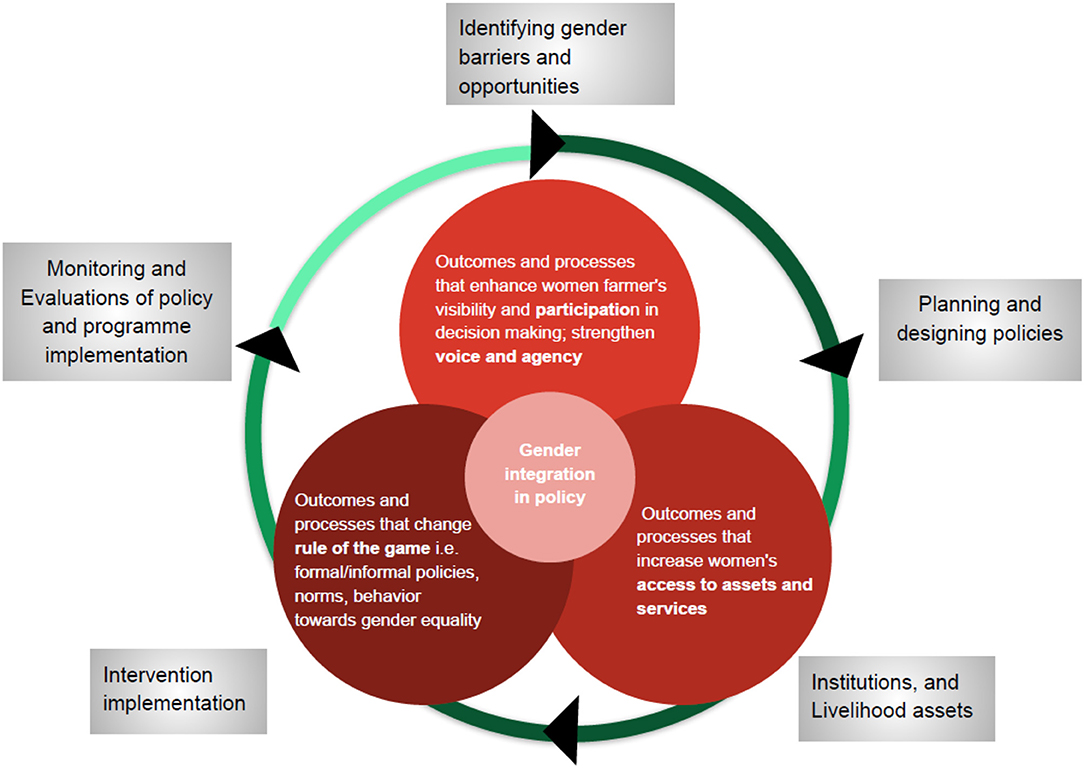- 1National Planning Commission of Nepal, Kathmandu, Nepal
- 2CGIAR Research Program on Climate Change, Agriculture and Food Security, Borlaug Institute for South Asia, International Maize and Wheat Improvement Center, CIMMYT, New Delhi, India
- 3Local Initiatives for Biodiversity, Research and Development (LI-BIRD), Kathmandu, Nepal
- 4Center for Biotechnology, Agriculture and Forestry University, Chitwan, Nepal
Gender integration across national policy processes is critical to ensure effective implementation of climate change adaptation interventions in agriculture. This is especially so for countries like Nepal, where climate vulnerability and women participation in agriculture is high, accompanied by gender gaps in access to information, technologies, markets, and labor burden. To do this, it becomes necessary to address the inter-related issues of gender, agriculture, and climate change instead of looking at them in isolation. This study, therefore, highlights policy gaps to suggest a set of recommendations for improving gender responsiveness at policy level in Nepal. It presents the gender gaps that women face in agriculture, based on data collected from five districts of the country. Subsequently, using the concept of gender-agriculture-climate change nexus, it analyses 20 government policies and related documents of Nepal based on a set of five indicators. The policy analysis elucidates the level of gender integration in agriculture and climate change policies in the country. Eleven of the 15 agriculture related documents acknowledge the need to focus on women farmers, with nine of them also defining provisions for women-related issues in agriculture. Two of the five climate change policies merely acknowledge gender issues related to climate change. However, only two of the 20 policy documents recognize the need to address gender, climate change, and agricultural issues in coherence. Accordingly, the paper proposes a framework highlighting key points to make policy process and implementation plans in the agriculture sector more gender responsive in Nepal, focusing on the development and promotion of gender responsive Climate-Smart Agriculture technologies and practices. It suggests measures to increase access of assets and services to women farmers, improve their capacity to participate in decision making across levels, and promote transformative changes at both local and policy level.
Introduction
As per the UNFCCC guidelines and requirements, several countries have developed climate change adaptation strategies and programs. National Adaptation Programme of Action (NAPA), National Climate Change Policies and Frameworks and Intended Nationally Determined Contributions (INDCs) highlight the processes through which the countries aim to achieve their national commitments related to climate change adaptation and mitigation in agriculture and allied sectors. Adaptation and mitigation to climate change forms an essential part of these commitments and involves various stakeholders including national, regional, and local level government bodies as well as the private sector. In countries where women play a key role in agriculture production, the extent of gender inclusiveness of these policies can play an essential role in determining the success of adaptation and mitigation actions in agriculture.
Various studies have shown that men and women farmers often have different abilities to adapt to climate change, variability, and weather related shocks, with women in many cases being affected more than men from climate related shocks and stresses (Goh, 2012; Quisumbing et al., 2017). This has been attributed to women's limited access to timely weather forecast information; limited available options for crop and livelihood diversification; lack of independent source of income, access to credit or financial institutions for better investment; and low decision-making power to apply adaptation measures (World Bank Group et al., 2015; Huyer, 2016; Milazzo and Goldstein, 2017). Consequently, there is a difference in adaptive capacities and vulnerabilities to climate change of men and women in agriculture (Fisher and Carr, 2015; Mersha and Van Laerhoven, 2016).
Agriculture employs around 60% of the women in South Asia (United Nations, 2015a). Women contribute significantly to agricultural production in activities ranging from cropland preparation and sowing to harvesting, livestock management, and post-harvest activities. Their considerable involvement highlights the need to address the gender gap in terms of access to resources, productivity, and vulnerability in agriculture in the wake of climate change (Nyasimi and Huyer, 2017; Chanana-Nag and Aggarwal, 2018). Enabling resource access and building capacity of women farmers can provide positive community outcomes (Hottle, 2015; Nyasimi et al., 2016). Strengthening the capacity of women farmers therefore is an essential step toward building resilient farm households, agricultural communities, and food systems (World Bank Group et al., 2015).
Over the past few years the UNFCCC has also established to ensure women's equality to effectively implement climate change mitigation and adaptation plans. Moreover, the UN Millennium Development Goals (United Nations, 2008) and subsequently the Sustainable Development Goals (United Nations, 2015b) have also been promoting gender equality and empowerment across sectors including agriculture. As a result, gender has been included as a part of the climate change agenda of many countries. However, the inclusion of a gender component as part of the policy documentation appears insufficient to meet the end objectives of reducing the gender gap in climate change adaptation. It therefore needs to be mainstreamed across policy processes including planning, focused implementation, sustainable financing mechanisms, capacity building, institutional coordination, and measurement of outcomes (Chaudhury et al., 2012; Kristjanson et al., 2017).
Few studies have tried to assess the level of gender inclusiveness across existing policies and budgets of countries. They highlight the structural gaps and challenges that exist in the current planning processes and recommend pro-active efforts to implement outcome oriented gender focused activities (Gumucio and Rueda, 2015; Ampaire et al., 2016; Aura et al., 2017). These are suggested as necessary steps to integrate gender in climate change planning. To build farmer resilience to climate risks, encouraging the adoption of practices leading to more transformative change such as Climate-Smart Agriculture (CSA) interventions can help in withstanding the effect of climate change while enhancing productivity and social equity (Lipper et al., 2014). CSA refers to all technologies and practices that assist in sustainably improving agricultural productivity, increase climate resilience as well as reduce greenhouse gas emissions, wherever possible (Lipper et al., 2014). There is a need to develop incentives mechanisms, improved agricultural practices, and more efficient input/output market and policy changes in favor of women farmers. This should be done keeping in mind the challenges related to agriculture in changing climate. These suggestions, specifically those related to CSA, remain largely absent in current climate related policy literature.
This study presents a policy analysis for Nepal. The importance of the study for Nepal is highlighted by the fact that the country's agricultural sector, contributing two-third to the country's Gross Domestic Product (GDP), employs 82% of the female workforce (World Bank, 2018). The country is also witnessing increasing feminization of agriculture due to a growing number of male out-migration from the country for labor and professional jobs (Gartaula et al., 2010; Tamang et al., 2014). At the same time, it is one of the lowest ranking countries as per the gender-related development indicators (CBS, 2013; UNDP, 2016).
The study has been conducted with three objectives; first, to understand gender issues in agriculture in Nepal, especially in relation to climate change and migration, second, to assess existing policy gaps with respect to gender integration in climate change and agriculture policies of Nepal, and third, to present a framework based on the above two objectives to promote gender integration and responsiveness in the policies. The study specifically focuses on CSA as a potential solution to some of the gender issues discussed.
Methodology
Data Collection and Discussion With Key Stakeholders
In 2017, primary data was collected through a survey of 503 households and five focus group discussion, in five districts of Nepal: Chitwan, Kaski, Kathmandu, Rupandehi, and Morang. The districts represent three different types (High, medium, and low) of hotspots of climate risks, women in agriculture and poverty levels in Nepal (Khatri-Chhetri et al., 2019). Female share of agricultural workforce in these districts averages 54%, ranging from 48% in Rupandehi to 61% in Kaski. In consultation with the implementing agencies and local NGO partners, 100 households per district were randomly selected. The objective of primary data collection was to gather information about climate risk profile at the local community level, women's involvement and role in agriculture and their access to production resources and information. All information about surveyed household are kept strictly confidential and their information cannot be personally identified in this paper and committed to ensuring absolute confidentiality followed by guidelines provided by the authors' organization. The study was approved by the ethics committee of Agriculture and Forestry University, Nepal. Written informed consent was obtained from all participants.
Additionally, a key stakeholders meeting was conducted in October 2017, with representatives from government ministries such as Ministry of Population and Environment, Nepal Climate Change Support Program, Ministry of Livestock Development, Ministry of Agriculture Development, non-government organizations (NGOs), international research and development organizations working in Nepal in agriculture sectors. The objective of the meeting was to critically reflect on policymaking process and key issues for gender integration into policies, plans, and resources. The participants shared good practices and learning from initiatives targeted at women farmers. Inputs from this discussion have been used to develop the suggested framework for gender integration in policy.
Analysis of National Policies and Programs
The study reviewed 20 current agriculture and climate change policy documents designed and being implemented in Nepal. National government policies, strategies, guidelines, and periodic plans were included in the review. The objective of this policy assessment was to explore the extent to which existing policies and programs acknowledge and respond to gendered impacts of climate change, and whether they provision for activities promoting gender responsive adaptation and mitigation in agriculture sector. This assessment was conducted based on the gender, agriculture, and climate change nexus as shown in Figure 1.
The content of all selected policies and programs were assessed based on the following indicators:
• Recognition of climate change impact on agriculture: This indicator reflects whether the policy mentions agriculture as one of the sectors impacted by climate change
• Policy provision for climate change adaptation in agriculture: This indicator represents the extent to which climate change impacts on agriculture are mentioned in the policy. This highlights that the policy not just specifies the impacts of climate change on agriculture but also provisions measures to adapt to the impacts
• Recognition of gender differentiated roles in agriculture: This indicator represents the union of agriculture and gender (as shown in Figure 1). It indicates only the mention of women's role in agriculture and/or the need to focus on women farmers in the policy document
• Policy provision for gender in agriculture: This indicator represents the extent to which gender is integrated within the policy and program. This highlights that the policy not just acknowledges the importance of a gender focus but also provisions measures to promote gender equality in the objective and processes of the policy plans and implementation
• Recognition of gender differentiated impacts of climate change in agriculture: This is the main indicator that points to the integration of all the three domains of climate change, agriculture, and climate change in the policy document. It includes the mention of climate impacts on women in agriculture or specifies gender differentiated impacts of climate change in agriculture
Results
Climatic Risk and Women's Involvement in Agriculture
Gender and Climate Risk Profile
Table 1 highlights the survey results related to gender differentiated responses about climate change experiences. Men respondents appeared to be more aware about climate change than women respondents. Higher overall temperatures, decrease in duration of winters and uneven weather fluctuation were the most commonly observed changes by both men and women farmers.
Group discussion with women farmers revealed that regions with less rainfall suffered from lower crop production especially those lacking irrigation facilities. Increase in pests, insects and diseases was also observed as a result of the climatic changes which further increased women's weeding time and also impacted production. Crops such as maize, mustard, wheat, and vegetables were more prone to damage due to rainfall related risks.
Gender Decision Making and Resource Access in Agriculture
With a high level of participation in agriculture, women farmers are also involved in decision making regarding different agricultural activities. As seen in Table 2, most of the decisions regarding major activities in the crop cycle, especially harvesting and post-harvesting, are jointly taken by the men and women of the household. Involvement of women in decision making is higher than men's in activities such as planting, sowing, and weeding. However, men are the dominant decision makers in activities related to technology adoption and land.
Of the surveyed households, 20% have at least one male migrant member. In these households, women are involved more in the decision making process with 43, 45, 53, and 39% of these households stating only women's involvement in planting, sowing, weeding, and harvesting, respectively. Group discussions also pointed to migration induced increased labor burden for women famers due to additional responsibilities relating to irrigation and pest control. Additionally, climate risks further exacerbate this labor burden, especially in situations of water shortages or increased pests.
During the discussions, women also highlighted their disadvantages compared to men with respect to limited access to land, fewer resources and entitlements as well as limited access to information and services. Social norms coupled with domestic workload restricted their access to information through local platforms. Information disseminated through mobile phone and mass media, such as television and radio was found to be more accessible to them.
Similar trends were observed among the surveyed households where radio, television, and newspaper were the most used sources of climate change information, although with gender differences in access (Table 3). All these factors add to the vulnerability of women farmers to climate risks, which further poses a threat to agricultural growth, given the significant extent of their involvement in the sector.
In the context of a changing climate and men outmigration, focusing on reducing women's vulnerabilities to climate risks requires policy attention. This can be done through the promotion of gender-responsive climate-smart agriculture technologies and practices. These need to be associated with capacity-building efforts to enable farmers to access these technologies, and apply them without strengthening existing inequalities in terms of gender roles and relations as well as labor hours.
Gender Integration in Planning: Policy Analysis
A total of 20 policies, strategies and guidelines, including 15 agricultural policies and five climate change policies, were analyzed as shown in Figure 2. The Government of Nepal (GoN) recognizes agriculture as one of the most vulnerable sectors to the changing climate as it has continued to prioritize agriculture and food production since the last few decades. The policies formulated during the last decade demonstrate increasing acknowledgment of climate change impacts in agriculture and include strategies for climate change adaptation and mitigation.
Figure 2. Climate change and agricultural policies and strategies adopted between 2004–2017 in Nepal. NAP, National Agriculture Policy 2004; GMS, Gender Mainstreaming Strategy 2006; NAES, Nepa1 Agriculture Extension Strategy 2007; NAPA, National Adaptation Program of Action to Climate Change 2010; CCP, Climate Change Policy 2011; LAPA, National Framework on Local Adaptation Plans for Action 2011; CCADRMA, Ciimate Change Adaptation and Disaster Risk Management in Agriculture: Priority framework for action 2011–2020; NARCV, National Agricultural Research Centre (NARC) Vision; NSV, National Seed Vision 2013–2025; IP, Irigation Policy (revised) 2013; CLIPGG, Crop and Livestock Insurance Premium Grant Guideline 2013; EFLGF, Environment Friendly Local Government Framework 2013; NABP, National Agro Biodiversity Policy 2006 (revised 2014); ADS, Agriculture Development Strategy ADS 2015–2035; ACGG, Agriculture Cooperative Grant Guideline 2015; GGOF, Grant guideline on organic fertiliser 2015; PP, 14th Periodic Plan 2016–2019; PPC, Piastic pond construction guideline 2016; RESP, Renewable Energy Subsidy Policy 2016; SIIG, Smalllrrigation (shallow tubewel) Implementation Guideline for drought affected districts 2017.
The policies, strategies, and guidelines directly impact the ability of farmers, especially women from different economic and social groups, to adapt to climate change. Sub-sectoral policies, guidelines, and plans are major instruments for the government to translate these policies and strategies into practice. An analysis of key agricultural and climate change policies and plans, as shown in Figure 3, explores the extent to which gender roles in agriculture, especially those of women farmers are acknowledged, and responded to. Fourteen out of the 20 policies recognize the impact of climate change on agriculture but only nine include provisions for adaptation. In terms of gender, 13 policies recognize the gender differentiated roles in agriculture by highlighting the need to focus on women farmers based on their significant involvement in the sector. Ten of these policies/programs also provide for provisions in the policy documents to either increase women's participation, improve their assets or build their capacity in different ways and forms. However, only two climate change policies recognize the gender differentiated impacts of climate change in agriculture with none of them provisioning for any kind of plan or strategy to address the impact.
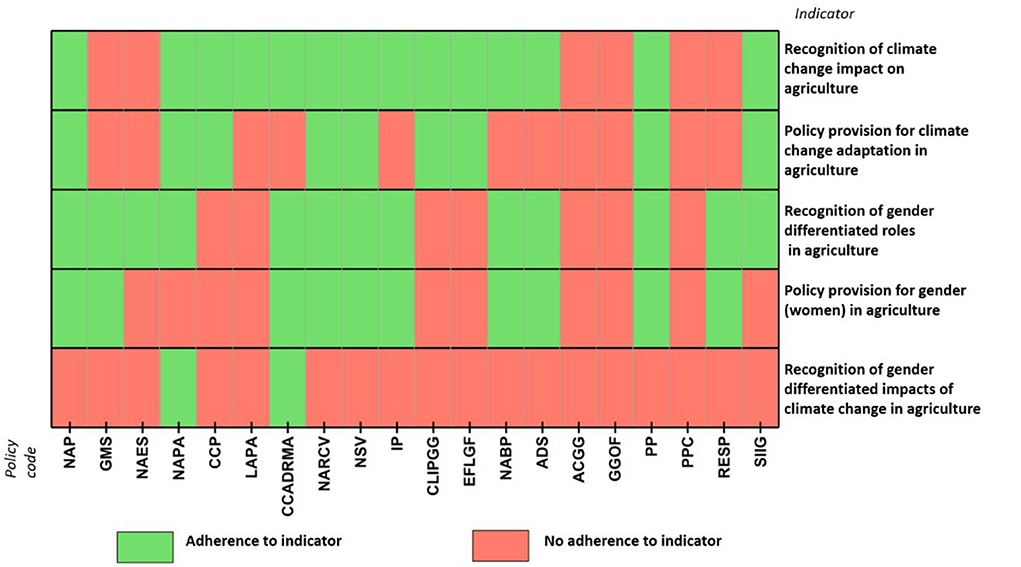
Figure 3. Analysis of key climate change and agricultural policies and strategies based on five indicators. NAP, National Agriculture Policy 2004; GMS, Gender Mainstreaming Strategy 2006; NAES, Nepa1 Agriculture Extension Strategy 2007; NAPA, National Adaptation Program of Action to Climate Change 2010; CCP, Climate Change Policy 2011; LAPA, National Framework on Local Adaptation Plans for Action 2011; CCADRMA, Ciimate Change Adaptation and Disaster Risk Management in Agriculture: Priority framework for action 2011–2020; NARCV, National Agricultural Research Centre (NARC) Vision; NSV, National Seed Vision 2013–2025; IP, Irigation Policy (revised) 2013; CLIPGG, Crop and Livestock Insurance Premium Grant Guideline 2013; EFLGF, Environment Friendly Local Government Framework 2013; NABP, National Agro Biodiversity Policy 2006 (revised 2014); ADS, Agriculture Development Strategy ADS 2015–2035; ACGG, Agriculture Cooperative Grant Guideline 2015; GGOF, Grant guideline on organic fertiliser 2015; PP, 14th Periodic Plan 2016–2019; PPC, Piastic pond construction guideline 2016; RESP, Renewable Energy Subsidy Policy 2016; SIIG, Smalllrrigation (shallow tubewel) Implementation Guideline for drought affected districts 2017.
Gender Integration in Agricultural Policies
Eleven of the 15 agricultural policies demonstrate an understanding of the role of women in agriculture and recognize them as a target group for focusing policy and program interventions. The National Agriculture Research Center (NARC) Vision highlights the need for gender sensitive research, development, and dissemination of agricultural technologies to improve agricultural productivity. The National Seed Vision also acknowledges the important role women can play in agriculture across activities and in particular, maintenance and use of seed.
Nine of these 11 policies/programs define provisions for addressing women specific vulnerabilities in agriculture sector. Some policies have explicit provisions, such as Agriculture Development Strategy which aims to increase women's land ownership from 10% (in 2010) to 50% by 2035. Similarly, Nepal's Gender Mainstreaming Strategy also aims to achieve 50% women participation in all agricultural production-related interventions, institutions and organizations. Other policies and programs propose gender and social inclusion studies for outreach, technology dissemination, and extension activities (NARC Vision), promoting capacity building efforts of women. They also suggest promotion of equal access for men and women farmers to information, skills, services, and seed use, minimizing entry barriers and improving income for women in seed value chain (National Seed Vision), and providing additional subsidy to women headed households (Renewable Energy Subsidy Policy).
However, despite provisions, most of them are silent on action plans and budget allocation to implement the provisions and fail to address specific issues faced by women farmers. The National Agriculture Policy provides explicit provisions to promote women's participation. However, it fails to address the specific social barriers that inhibit women's participation from the suggested activities in the policy document. Similarly, Nepal Agricultural Extension Strategy can potentially play a significant role in reducing constraints related to women's mobility, access to information, skills, credit, and services at the local level but lacks gender sensitive measures within the policy. The National Agro-biodiversity Policy is silent on whether and how women farmers will be reached and benefitted in the process of identification, protection, conservation, promotion, and sustainable use of agro-biodiversity.
As observed from group discussions, increasing male outmigration has significantly increased women's role and therefore their drudgery in agriculture. This expanded gender role of women farmers is not acknowledged in the Irrigation Policy. The policy is silent on promoting women specific measures to increase their access and affordability to irrigation. In addition, most of the incentive schemes and guidelines to implement the policies consider households as beneficiaries, thus ignoring the intra-household dynamics including limited access to the benefits of these schemes for women farmers. For instance, the Crop and Livestock insurance guideline provides up to 50% subsidy/grant to farmers. However, it fails to address barriers such as access to scheme information, access to credit for buying insurance, decision making authority, and bureaucratic administrative procedure which discourage women to participate in the scheme.
Gender Integration in Climate Change Policies
Only two of the five climate change policies acknowledge gender issues related to climate change, with only one of them suggesting adaptation measures specifically targeted at women. Climate Change Adaptation and Disaster Risk Management in Agriculture policy recognizes the role of women in agriculture and the challenges faced by them. It has also integrated gender across key areas of the policy framework and assigns specific activities and monitoring indicators. Similarly, the NAPA acknowledges both the vulnerability of agriculture and gendered impacts of climate change in the sector. However, the extent of gender integration remains limited to recognition of women as a vulnerable group and does not specify any policy measure or action plan to address the climate change vulnerability of women. The Climate Change Policy, on the other hand, adopts a gender neutral approach to CSA interventions in agriculture, despite being one of the key documents guiding overall climate change related interventions in Nepal.
Interlinkages Among Gender, Agriculture, and Climate Change Across Policies
Of the nine policies that specify measures or provisions for climate change adaptation, some also include provisions related to promotion of CSA technologies and practices, such as developing climate resilient varieties for adaptation, sustainable soil, and water management, promotion of on-farm agro-biodiversity management, and integrated pest management. They also promote adaptation needs assessment, capacity building of stakeholders and communities, and provisions for financial and institutional arrangements relevant to CSA. However, only two of these policies, namely the National Adaptation Programme of Action (NAPA) and the Climate Change Adaptation and Disaster Risk Management in Agriculture Priority Framework, encourage efforts to promote gender sensitive technologies for climate change adaptation.
The Agriculture Development Strategy is the most coherent document in terms of recognizing the negative impacts of climate change on agriculture productivity and the need for introducing appropriate adaptation mechanisms, including CSA. However, the strategy is silent on differential effect of climate change on women farmers and therefore the gender specific measures to respond to the differential effect. The Gender Mainstreaming Strategy in agriculture, though focused on gender integration across sectors, also remains silent on the differentiated impact of climate change on men and women and the need for specific interventions in the context of climate change. Moreover, the strategy only provides overall directives and framework. For the provisions to be effective, the strategy needs to be integrated into other sectoral plans and budget. The 14th Development Plan and Agriculture Modernization Project has an explicit focus to develop and disseminate environment friendly agro-technologies to minimize the adverse impacts of climate change. While it also has a specific focus on gender equality and women's empowerment in general, it lacks consistency and coherence between agriculture, climate change, and gender equality related activities and schemes.
Thus, the above analysis highlights that while gender integration within the agriculture and climate change policies is limited, the reference to gender in agriculture in the wake of climate change also remains a major gap across policies.
Gender Budgeting
The Nepal government uses gender responsive budgeting with specific budget codes for tracking resource allocation from different agencies for women specific activities. In agriculture and livestock sectors, for the fiscal year 2017–2018, out of NPR 30.40 billion, about 3.3 million has been directly allocated for activities aimed to reach and benefit women. However, there is no indication toward the use of these funds for climate change related adaptation efforts. An analysis of the budget allocation of different ministries highlights a significant increase in the proportion of fund allocation toward climate change from 10.3% in FY 2013-14 to 30.8% in FY17-18 as seen in Figure 4 (MoPE, 2016). Out of the NPR 393.4 billion allocated for climate action in FY 2017–18, an amount of NPR 49.14 billion is allotted to the agricultural sector. However, the plan and expenditure is gender neutral.
Discussions
Framework for Gender Integration in Policies and Programs
Development and promotion of CSA technologies and practices is being increasingly adopted as a policy approach to respond to climate change effects in agriculture in Nepal (CIAT et al., 2017; Paudel et al., 2017). However, in order to make CSA gender responsive, it is essential to develop the necessary enabling conditions at a local level to encourage CSA adoption by women farmers (Huyer, 2016). To be gender-responsive involves a comprehensive approach of understanding the gender specific needs, priorities and challenges, building capacities to address the needs and empowering men and women to move toward gender equality. Policy plans and programmes therefore need to incorporate a combination of approaches to reach (for their participation, voice, and agency), benefit (with access to livelihood assets and opportunities) and empower women (by changing norms toward gender equality) in a more coherent and consistent manner (Johnson et al., 2018). Based on this, a framework is suggested to enable a gender responsive policy implementation in agriculture under a changing climate in Nepal.
The framework (Figure 5) integrates two approaches: the programme cycle model for enhancing gender equity in CSA and the three domains of change as part of the Nepal Gender and Social Exclusion Assessment (GSEA) framework (World Bank, 2006; Beuchelt and Badstue, 2013). The three domains of change in the center define the plans and activties across all stages of the policy making process, which is represented by the outer cycle of programme management. A gender analysis, to identify barriers and opportunities, informs policies at all levels to ensure that both practical and strategic gender needs are being met.
Policies and strategies can be formulated to address these specific gender gaps through formulation of specific schemes and incentives targeted toward women to improve their access to assets and services. These schemes and incentives need to be supported by adequate financial, human, social, physical as well as natural resources to be implemented in a gender responsive manner. Interventions should also be holistic in the sense that there is a balance between the interventions that–increases women farmer's access to assets and services; provides space for women to participate in decision-making; build their capacity to influence the decisions as well as change the existing norms and rules to transform unequal relations of power. Monitoring and evaluation can cover both results and processes to ensure that the outcomes are holistic, sustainable, and empowering toward gender equity. Based on the framework, key recommendations are provided to improve gender integration in the policy process and encourage gender-responsive policy formulation and implementation.
Increasing Access to Assets and Services to Women Farmers
Women farmers in Nepal lack access to critical agricultural inputs like land, labor, credit, equipment, and services, restricting their capabilities to adopt CSA. As seen in the primary results, their participation in decision making related to technology adoption and land is also limited. The policy revision, therefore, needs to address this gap. This can be done in two ways, through disaggregated data and development of gender responsive CSA technologies and practices. Establishing disaggregated information is the primary requirement to address knowledge gap and to identify gender barriers and opportunities. Policy makers lack reliable comprehensive set of disaggregated data especially on climate change impact, participation of men and women in agriculture, climate change adaptation activities, and access to goods and services. Generation, processing and dissemination of gender disaggregated data can provide quantitative and qualitative evidence to fill these gaps. Such evidence can then be used in a coherent way, while formulating policies, programs, and allocating resources to ensure a gender responsive policy formulation and implementation. At the same time, there is a need to develop innovative gender-responsive CSA technologies, such as those related to labor reduction (especially in male out-migration areas), to reduce gender disparities in technology adoption. Moreover, it is also essential for the technology generation processes to incorporate gender-based indigenous knowledge and skills that may enable women (and men) to access and use the technologies better.
Enhancing Women's Participation in Decision-Making Process
Several measures can be suggested to improve women's participation explicitly in policies and programme at both micro and macro level. Formulation of Gender Focal Desks at the ministry level can ensure integration of gender perspective in policies, budgets, as well as periodic and annual plans. Also, monitoring whether and how women have been participating in macro and micro level policy making and in the implementation of CSA programmes can help to identify whether these processes are empowering, reaching, and benefiting women farmers in the long run. Establishing mechanisms at the local level where women farmers' groups and women cooperatives can express their needs in the context of the changing climate can also help in building their agency. This process can encourage women to participate effectively in the integrated planning process to incorporate gender in both climate change adaptation and agriculture development plans, including revision and implementation of Community Adaptation Plans of Action (CAPA) and Local Adaptation Plans of Action (LAPA).
Additionally, promoting gender sensitization and responsiveness among the local CSA service providers and agencies can assist in overcoming operational barriers for women participation. All of these measures require enhancing capacity and creating an enabling environment to build agency of women farmers. Specific plans are needed for gender sensitization and capacity building for researchers, policy makers and implementing institutions on gender analysis, gender responsive planning, implementation, and monitoring, especially in the context of CSA and its potential for women farmers.
Changing Rules of the Game Toward Gender Equality
The existing state of gender integration in Nepal requires interventions which not only challenge the existing norms and behavior of men and women, but also stimulates changes in attitude, behavior as well as values of researchers, policy makers, practitioners, and service providers. Practices leading to more transformative change such as diversified livelihood options and CSA interventions are needed if agriculture is to withstand the effect of climate. Increasing access of women to financial institutions and markets, and mandatory provisions for women to participate in macro and micro level policies and plans are some examples of the interventions that can potentially “change the rules of the game” in favor of women farmers. These need to be promoted by policies, institutions, and interventions at both the national, state, and local level. Similarly, integrating a gender component in climate finance derived from various governments and donor agencies with targeted allocation to meet gender needs is also necessary. At the same time, interventions need to acknowledge and respond to the changing gender roles due to male out-migration.
Conclusions
The paper analyses the extent of gender integration in 20 climate change and agricultural policies in Nepal. To set the context, collected primary data highlights the issues related to access to information and increased labor burden as a result of male-outmigration.
The policy analysis brings out the gaps which exist in terms of acknowledging and provisioning for gender in the agriculture and climate change related policies and documents. Although, gender is acknowledged in most of these policies as an area requiring attention, the scope for intervention is mostly restricted to increasing reach and participation of women farmers in the policy implementation. Consequently, the paper provides recommendations based on a framework to make gender, agriculture climate change nexus explicit in policy response and to encourage synergies between policies, planning, and implementation.
The policy revision needs to not only integrate gender in all the provisions, but also classify and ensure a careful balance among the provisions that allow women's reach and participation; to benefit them directly by reducing workload or improving agricultural information and input access, as well as by transforming gender power relations. Gender mainstreaming at policy level also needs to integrate local gender norms to support the transformative potential of policy action (Acosta et al., 2019). Improving representation of women and building their capacity for effective participation in key policymaking positions, especially those related to agriculture and climate change, can play an important role in addressing policy gaps.
Author Contributions
BP, NC, and AK-C wrote the paper with contributions from other authors. In addition, BP, NC, and AK-C contributed to conception and design of the study and framework for gender integration in policy. NC, LS, and IK have conducted primary data collection and analysis. PA contributed to structuring the analyses in the paper.
Conflict of Interest Statement
The authors declare that the research was conducted in the absence of any commercial or financial relationships that could be construed as a potential conflict of interest.
Acknowledgments
This work was implemented as part of the CGIAR Research Program on Climate Change, Agriculture and Food Security (CCAFS), which is carried out with support from the CGIAR Trust Fund Donors and through bilateral funding agreements. For details please visit https://ccafs.cgiar.org/donors. The views expressed in this document cannot be taken to reflect the official opinions of these organizations.
References
Acosta, M., van Bommel, S., van Wessel, M., Ampaire, E. L., Jassogne, L., and Feindt, P. H. (2019). Discursive translations of gender mainstreaming norms: The case of agricultural and climate change policies in Uganda. Women Stud. Int. Forum 74, 9–19. doi: 10.1016/j.wsif.2019.02.010
Ampaire, E., Acosta, M., Kigonya, R., Kyomugisha, S., Muchunguzi, P., and Jassogne, L. (2016). Gender Responsive Policy Formulation and Budgeting in Tanzania: Do Plans and Budgets Match? CCAFS Info Note. Copenhagen: CGIAR Research Program on Climate Change, Agriculture and Food Security (CCAFS).
Aura, R., Nyasimi, M., Cramer, L., and Thornton, P. (2017). Gender Review of Climate Change Legislative and Policy Frameworks and Strategies in East Africa. CCAFS Working Paper no. 209. Wageningen: CGIAR Research Program on Climate Change, Agriculture and Food Security (CCAFS).
Beuchelt, T. D., and Badstue, L. (2013). Gender, nutrition-and climate-smart food production: opportunities and trade-offs. Food Sec. 5,709–721. doi: 10.1007/s12571-013-0290-8
CBS (2013). National Sample Census of Agriculture Nepal 2011/2012: National Report. Kathmandu: Central Bureau of Statistics.
Chanana-Nag, N., and Aggarwal, P. K. (2018). Woman in agriculture, and climate risks: hotspots for development. Clim. Change 1–15. doi: 10.1007/s10584-018-2233-z
Chaudhury, M., Kristjanson, P., Kyagazze, F., Naab, J. B., and Neelormi, S. (2012). Participatory Gender-Sensitive Approaches for Addressing Key Climate Change Related Research Issues: Evidence From Bangladesh, Ghana, and Uganda. Working Paper 19. Copenhagen: CGIAR Research Program on Climate Change, Agriculture and Food Security (CCAFS).
CIAT World Bank, CCAFS, and LI-BIRD. (2017). Climate-Smart Agriculture in Nepal. CSA Country Profiles for Asia Series. Washington, DC: International Center for Tropical Agriculture (CIAT); the World Bank; CGIAR Research Program on Climate Change, Agriculture and Food Security (CCAFS).
Fisher, M., and Carr, E. R. (2015). The influence of gendered roles and responsibilities on the adoption of technologies that mitigate drought risk: the case of drought-tolerant maize seed in eastern Uganda. Glob. Environ. Change 35, 82–92. doi: 10.1016/j.gloenvcha.2015.08.009
Gartaula, H. N., Niehof, N., and Leontine, V. (2010). Feminization of agriculture as an effect of male out-migration: unexpected outcomes from Jhapa District, Eastern Nepal. Int. J. Interdisc. Soc. Sci. 5, 565–577. doi: 10.18848/1833-1882/CGP/v05i02/51588
Goh, A.H. X. (2012). A Literature Review of the Gender-Differentiated Impacts of Climate Change on Women's and Men's Assets and Well-Being in Developing Countries. CAPRi Working Paper No. 106. Washington, DC: International Food Policy Research Institute.
Gumucio, T., and Rueda, M. T. (2015). Influencing gender-inclusive climate change policies in Latin America. J. Gender Agr. Food Sec. 1, 42–61. doi: 10.19268/JGAFS.122015.3
Hottle, R. (2015). Women-Led Agroforestry and Improved Cookstoves in Honduras: Field Evaluation of Farmer-Led Gender-Transformative Strategies for Low Emissions Agriculture. Working Paper No. 125. Copenhagen: CGIAR Research Program on Climate Change, Agriculture and Food Security (CCAFS).
Huyer, S. (2016). Closing the gender gap in agriculture. Gender Technol. Dev. 20,105–116. doi: 10.1177/0971852416643872
Johnson, N., Balagamwala, M., Pinkstaff, C., Theis, S., Meinzen-Dick, R., and Quisumbing, A. (2018). How do agricultural development projects empower women? Linking strategies with expected outcomes. J. Gend. Agric. Food Secur. 3, 1–19. Available online at: http://agrigender.net/uploads/JGAFS-322018-1-Paper.pdf
Khatri-Chhetri, A., Regmi, P. P., Chanana, N., and Aggarwal, P. K. (2019). Potential of climate-smart agriculture in reducing women farmers' drudgery in high climatic risk areas. Clim. Change 1–14. doi: 10.1007/s10584-018-2350-8
Kristjanson, P., Bryan, E., Bernier, Q., Twyman, J., Meinzen-Dick, R., Kieran, C., et al. (2017). Addressing gender in agricultural research for development in the face of a changing climate: where are we and where should we be going? Int. J. Agr. Sustainab. 15, 482–500. doi: 10.1080/14735903.2017.1336411
Lipper, L., Thornton, P., Campbell, B. M., et al. (2014). Climate smart agriculture for food security. Nat. Clim. Change 4,1068–1072. doi: 10.1038/nclimate2437
Mersha, A. A., and Van Laerhoven, F. (2016). A gender approach to understanding the differentiated impact of barriers to adaptation: responses to climate change in rural. Reg. Environ. Change 16,1701–1713. doi: 10.1007/s10113-015-0921-z
Milazzo, A., and Goldstein, M. P. (2017). World Development Report 2017: Governance and Women's Economic and Political Participation–Power Inequalities, Formal Constraints, and Norms (English). World Development Report. Washington, DC: World Bank Group.
MoPE (2016). Access to Climate Finance in Nepal. Kathmandu: Minisry of Population and Environment (GoN) and Prakriti Resources Centre, MoPE.
Nyasimi, M., and Huyer, S. (2017). Closing the gender gap in agriculture under climate change. Agr. Dev. 30, 37–40.
Nyasimi, M., Radeny, M., Kimeli, P., Mungai, C., Sayula, G., and Kinyangi, J. (2016). Uptake and Dissemination Pathways for Climate-Smart Agriculture Technologies and Practices in Lushoto, Tanzania. CCAFS Working Paper No. 173. Copenhagen: CGIAR Research Program on Climate Change, Agriculture and Food Security (CCAFS). p. 41
Paudel, B., Khanal, R. C., Khatri-Chhetri, A., Bhatta, K., and Chaudhary, P. (2017). Policy brief: Climate-smart agriculture in Nepal: Champion technologies and their pathways for scaling up. London: Climate and Development Knowledge Network.
Quisumbing, A. R., Kumar, N., and Behrman, J. A. (2017). Do shocks affect men's and women's assets differently? Evidence from Bangladesh and Uganda. Dev. Policy Rev. 36, 3–34. doi: 10.1111/dpr.12235
Tamang, S., Paudel, K. P., and Shrestha, K. K. (2014). Feminization of agriculture and its implications for food security in rural Nepal. J. Forest Livelihood 12, 20–32.
UNDP (2016). Human Development Report 2016: Human Development for Everyone. New York, NY: The United Nations Development Program.
United Nations (2015a). The World's Women 2015: Trends and Statistics. New York, NY: United Nations; Department of Economic and Social Affairs, Statistics Division.
United Nations (2015b). Transforming Our World: The 2030 Agenda for Sustainable Development. New York, NY: United Nations.
World Bank (2006). Unequal Citizens: Gender, Caste and Ethnic Exclusion in Nepal (Vol. 2): Executive Summary (English). Washington, DC: World Bank.
World Bank (2018). DataBank. Available online at: https://databank.worldbank.org/data/home.aspx (accessed July 01, 2019).
Keywords: climate change adaptation, climate-smart agriculture, gender, Nepal, policy
Citation: Paudyal BR, Chanana N, Khatri-Chhetri A, Sherpa L, Kadariya I and Aggarwal P (2019) Gender Integration in Climate Change and Agricultural Policies: The Case of Nepal. Front. Sustain. Food Syst. 3:66. doi: 10.3389/fsufs.2019.00066
Received: 03 November 2018; Accepted: 06 August 2019;
Published: 23 August 2019.
Edited by:
Lars Otto Naess, Institute of Development Studies (IDS), United KingdomReviewed by:
Tek B. Sapkota, The International Maize and Wheat Improvement Center (CIMMYT), IndiaFrancisco Javier Solorio, Universidad Autónoma de Yucatán, Mexico
Copyright © 2019 Paudyal, Chanana, Khatri-Chhetri, Sherpa, Kadariya and Aggarwal. This is an open-access article distributed under the terms of the Creative Commons Attribution License (CC BY). The use, distribution or reproduction in other forums is permitted, provided the original author(s) and the copyright owner(s) are credited and that the original publication in this journal is cited, in accordance with accepted academic practice. No use, distribution or reproduction is permitted which does not comply with these terms.
*Correspondence: Arun Khatri-Chhetri, YS5raGF0cmktY2hoZXRyaUBjZ2lhci5vcmc=
†Present address: Bimala Rai Paudyal, National Assembly, Federal Parliament of Nepal, Kathmandu, Nepal
‡These authors have contributed equally to this work
 Bimala Rai Paudyal
Bimala Rai Paudyal Nitya Chanana
Nitya Chanana Arun Khatri-Chhetri
Arun Khatri-Chhetri Lakpa Sherpa3
Lakpa Sherpa3 Pramod Aggarwal
Pramod Aggarwal